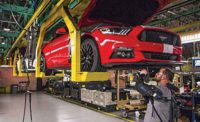MUNICH—Automotive suppliers are facing substantial shifts in regional positioning, component growth and OEM customer structure. To survive and thrive during the rest of this turbulent decade, manufacturers need to focus heavily on electric vehicle components.
Traditional suppliers in Europe and North America are currently not investing enough to foster necessary innovations, claims a recent study conducted by Roland Berger, a consulting firm that specializes in manufacturing and operations management.
“They are experiencing fluctuating volumes and suffering from a lack of economies of scale in production, high raw material and energy prices, pricing pressure from OEMs, a shortage of skilled labor and rising interest rates,” warns Felix Mogge, a partner at Roland Berger.
“However, it is these very investments in innovation that will be crucial to success if companies are to hold their own against Asian industry peers,” claims Mogge. “Automotive suppliers can only adapt their business model to new technologies with the necessary flexibility if they have a global strategy geared toward innovation.
“Many suppliers are in need of dedicated performance programs to stabilize margins and protect the business against future uncertainties," says Mogge. "They need to reconsider all their business activities, but specifically their product portfolio, production sites and supply chain structures.”
According to Mogge, automotive suppliers can be divided into two categories. On one hand, there are new, highly profitable companies focused primarily on batteries, semiconductors and software. These companies compete with incumbent suppliers while expanding their traditional portfolios beyond industry and consumer goods. The new suppliers are experiencing strong growth in the automotive sector and are achieving very high margins across all business areas.
For instance, while margins in the battery segment were around 10 percent in 2022, semiconductor suppliers attained an earnings before interest and taxes (EBIT) margin of around 30 percent, reaching as much as 35 percent for software providers.
On the other side of the equation are traditional automotive suppliers. Their record profits of the last decade are long gone. Mogge claims that the “new normal” for legacy suppliers is EBIT margins of 5 percent or less.
“The new competitors, with their innovative hardware and software solutions, perform significantly better in comparison,” explains Mogge. "This is not only due to the product they are selling; it is also because they can react flexibly to market developments and customer requirements, and invest capital in attractive growth segments.”
In addition to the new competitors, Asian suppliers are currently among the market winners. They are growing alongside the OEMs they supply as local production figures rise.
Asian suppliers are also benefiting significantly from power train electrification and digitalization—technologies that auto manufacturers in that region have been focusing on for some time.
Overall, Mogge believes the automotive supplier market will remain a growth business in the future, but with different components, for different customers and from different suppliers than at present.
By 2030, the market size is projected to grow by more than 30 percent, reaching a total of $1.3 trillion, with an annual growth rate of 4 percent. However, manufacturers of standard mechanical components and internal combustion engine technologies may lose more than 10 percent of their current market volume during this period.


